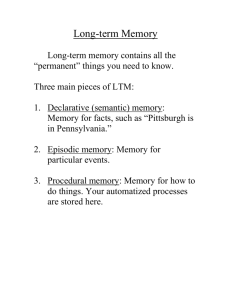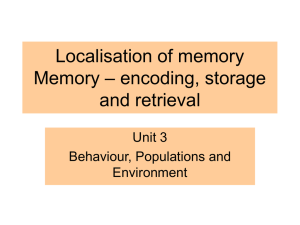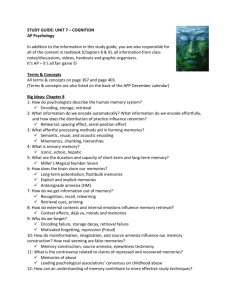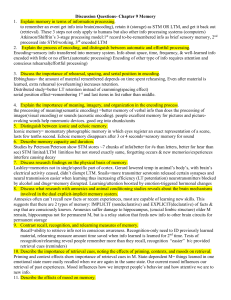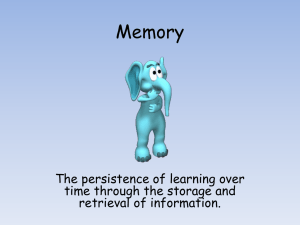Okami Study Guide
advertisement
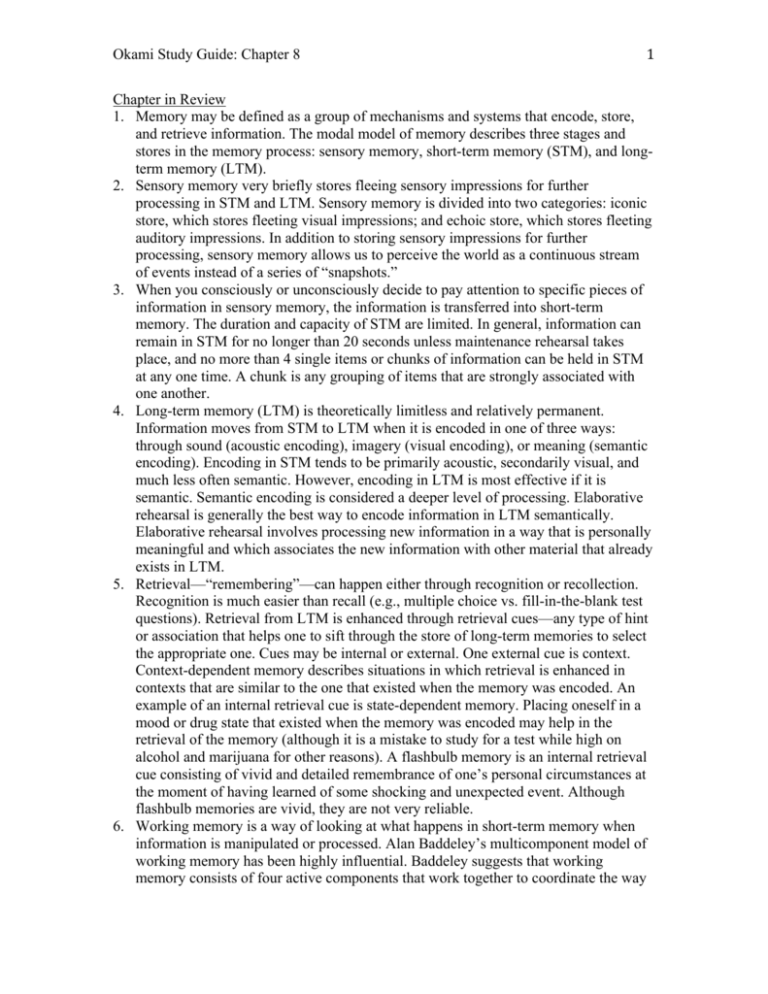
Okami Study Guide: Chapter 8 1 Chapter in Review 1. Memory may be defined as a group of mechanisms and systems that encode, store, and retrieve information. The modal model of memory describes three stages and stores in the memory process: sensory memory, short-term memory (STM), and longterm memory (LTM). 2. Sensory memory very briefly stores fleeing sensory impressions for further processing in STM and LTM. Sensory memory is divided into two categories: iconic store, which stores fleeting visual impressions; and echoic store, which stores fleeting auditory impressions. In addition to storing sensory impressions for further processing, sensory memory allows us to perceive the world as a continuous stream of events instead of a series of “snapshots.” 3. When you consciously or unconsciously decide to pay attention to specific pieces of information in sensory memory, the information is transferred into short-term memory. The duration and capacity of STM are limited. In general, information can remain in STM for no longer than 20 seconds unless maintenance rehearsal takes place, and no more than 4 single items or chunks of information can be held in STM at any one time. A chunk is any grouping of items that are strongly associated with one another. 4. Long-term memory (LTM) is theoretically limitless and relatively permanent. Information moves from STM to LTM when it is encoded in one of three ways: through sound (acoustic encoding), imagery (visual encoding), or meaning (semantic encoding). Encoding in STM tends to be primarily acoustic, secondarily visual, and much less often semantic. However, encoding in LTM is most effective if it is semantic. Semantic encoding is considered a deeper level of processing. Elaborative rehearsal is generally the best way to encode information in LTM semantically. Elaborative rehearsal involves processing new information in a way that is personally meaningful and which associates the new information with other material that already exists in LTM. 5. Retrieval—“remembering”—can happen either through recognition or recollection. Recognition is much easier than recall (e.g., multiple choice vs. fill-in-the-blank test questions). Retrieval from LTM is enhanced through retrieval cues—any type of hint or association that helps one to sift through the store of long-term memories to select the appropriate one. Cues may be internal or external. One external cue is context. Context-dependent memory describes situations in which retrieval is enhanced in contexts that are similar to the one that existed when the memory was encoded. An example of an internal retrieval cue is state-dependent memory. Placing oneself in a mood or drug state that existed when the memory was encoded may help in the retrieval of the memory (although it is a mistake to study for a test while high on alcohol and marijuana for other reasons). A flashbulb memory is an internal retrieval cue consisting of vivid and detailed remembrance of one’s personal circumstances at the moment of having learned of some shocking and unexpected event. Although flashbulb memories are vivid, they are not very reliable. 6. Working memory is a way of looking at what happens in short-term memory when information is manipulated or processed. Alan Baddeley’s multicomponent model of working memory has been highly influential. Baddeley suggests that working memory consists of four active components that work together to coordinate the way Okami Study Guide: Chapter 8 2 short-term memories are encoded and maintained in STM, transferred to LTM, and retrieved from LTM for short-term use. The components are the phonologic loop, the visuospatial sketchpad, the episodic buffer, and the central executive. 7. There are two types (and two subtypes) of LTM. Explicit memories are conscious memories for personal experiences or facts about the world. There are two subtypes of explicit memory: episodic memories (memories for personal experience) and semantic memories (memories for learned facts). Implicit memory occurs when we recall something but have no awareness that we are doing so (e.g., while driving a car we are recalling a varied number of skills, but have no recollection of having learned any given one of them). Implicit memory is most frequently expressed as (1) procedural memory (implicit memory for skills involving motor coordination, e.g., walking, driving, flipping a pancake); and (2) repetition priming, which refers to the way a person’s performance on a task can improve without that person’s awareness— simply as a result of previous exposure to the task. 8. The idea that information can be encoded at deeper or shallower levels originated in the levels of processing framework of Fergus Craik and Robert Lockhart. Craik and Lockhart do not agree with the notion that memory consists of separate stores and stages as in the modal model. They propose instead that the more deeply an item is processed, the more likely it is to be recalled later, and they suggest that so-called “short-term memory” simply represents shallower levels of processing, while LTM results from deeper levels. Although this idea has been very influential in cognitive psychology overall, it lacks some of the attributes of a true explanatory theory of memory, and works best as a guide for research. Moreover, there is some evidence to support the existence of separate stages and stores of memory (e.g., existence of the serial position curve and various neuroimaging studies). 9. Although there are many techniques available to enhance memory in test-taking situations, these techniques may or may not work well for any given person in a given context or situation. To do well studying for exams, a person needs a wide repertoire of tactics that are adaptable for many contexts. However, there are many classroom and study habits known to reduce exam performance across the board. These include: sitting toward the back of the classroom, studying in long but infrequent sessions, studying with distractions, skipping classes, studying high on alcohol or marijuana, and mistaking reading and re-reading for studying. 10. Psychostimulant “smart drugs” (e.g., Aderall, Provigil) are derived from amphetamine and commonly used (among other purposes) to enhance cognitive functioning and improve intellectual performance, focus, concentration, and memory. These drugs do appear to work at least to some extent. However, they do not work for everyone, and their effects may lessen over time. Moreover, the drugs often have unpleasant side effects, and their long-term safety has not been established. Like the use of steroid drugs by athletes, the use of psychostimulants raises ethical issues. 11. Memories are constructed, not recorded. Thus, eyewitness testimony can be surprisingly unreliable. Numbers of defendants convicted of crimes primarily on the basis of eyewitness testimony have been exonerated through DNA testing. Children’s memories of alleged traumatic abuse can also be manipulated to a surprising degree. Because of revelations of false accusations of abuse arising from improper interview techniques, and the number of eyewitness accounts demonstrated to have been false, Okami Study Guide: Chapter 8 3 many memory researchers have moved away from questions of how much information can be stored in memory (and for how long) to questions of the accuracy of memories. 12. Daniel Schachter has catalogued problems of forgetting and memory distortion in seven categories he calls the “seven sins of memory.” Sins of forgetting include transience, absentmindedness, and blocking. Transience describes the ordinary “fading” of memories—what most people mean when they speak of “forgetting.” Transience is likely caused primarily by proactive and retroactive interference. Absentmindedness is a lapse of attention that results in a failure to recall information. Absentmindedness happens either because information was not encoded properly— and thus is not available for retrieval—or because the information was encoded, but at the moment of attempted retrieval there is a massive distraction that prevents recall. Blocking refers to a situation where a memory has been encoded properly, is not subject to interference or distraction, and ought to be available for retrieval, but yet is not recalled. Blocking occurs primarily for names. 13. Sins of memory distortion include misattribution, suggestibility, and bias. (A seventh sin, persistence, refers to the intrusion of unwanted memories upon consciousness.) Misattribution is a distortion of memory where a person attributes a memory to a source other than its actual origin. Misattribution can result in entirely false beliefs that one has experienced an event when one has not (but someone else may have); or it can result in false beliefs about specific aspects of events that one has experienced. Schemas and scripts may contribute to misattribution and other instances of false memory because people often falsely remember details or events because they are strongly consistent with an existing schema or script. In other cases, people may be most likely to correctly recall details or events that are inconsistent with existing scripts or schemas for a particular situation. Suggestibility is a specific type of misattribution that results from intentional or unintentional suggestions from other people. Elizabeth Loftus has been researching suggestibility for 30 years. Much of her early work concerned the misinformation effect, where false information heard about an event after having experienced or viewed the event results in false memories of the event. Loftus has also produced startling research on rich false memory—a vivid false memory replete with extensive detail and emotional content. Cognitive biases such as the egocentric bias and the consistency bias may also result in distorted or false memories. 14. The notion that traumatic memories may be repressed and hidden from later recall has been highly controversial. Research has established that the more traumatic the experience, the more likely it is to be recalled, and the more accurate the recollection. Although some traumatic memories may be completely forgotten for many years and later recalled, it is not clear whether this is simple forgetting, as many types of memories are forgotten and then later recalled, or if “repression” is the cause. Most “recovered memories” of sexual abuse unravel because the abuse is shown never to have taken place, the memory has been shown likely to have originated in suggestive or coercive psychotherapy sessions, the events recalled are wildly improbable (or physically impossible), or for other reasons. Although there is no way to tell a false from a true instance of a recovered memory with certainty, conclusively documented cases differ in certain respects from the typical account. Okami Study Guide: Chapter 8 4 15. Some researchers suggest that our memory systems are imperfect because they have been constructed over evolutionary time in a somewhat haphazard fashion and survived because they are “good enough” to do the job most of the time. However, Daniel Schachter suggests that mechanisms of forgetting and even distortion serve adaptive functions. He claims that the difficulties caused by forgetting and distortion are evolutionary “trade-offs” which cause fewer problems than we would encounter if forgetting and memory distortion did not exist. For example, in forgetting, unnecessary information and details are lost so that the mind does not become “an overwhelming clutter of useless details.” This allows cognitive resources to be applied where they are needed. Okami Study Guide: Chapter 8 5 Section Summaries What is memory? 1. Psychologists define memory as a group of mechanisms and processes that encode, store, and retrieve information. 2. The modal model of memory describes memory in three stages, or stores: sensory memory, which fleetingly stores sensory perceptions; short-term memory (STM), which is limited in capacity and duration; and long-term memory (LTM), which is a theoretically unlimited long-term store. 3. STM can hold information for no longer than about 20 seconds unless it is rehearsed. Generally, no more than four items or chunks of items can be maintained in STM at one time. 4. There are three types of encoding: acoustic, visual, and semantic. Acoustic and visual encoding are more typical of STM (particularly acoustic encoding), and semantic encoding is more typical of LTM. What is remembering? 1. Retrieval cues enhance retrieval of long-term memories. Retrieval cues include context effects, state effects, and flashbulb memories. 2. Working memory is a contemporary way of looking at what happens in short-term memory when information is manipulated or processed. The most influential model of working memory is the multicomponent model of Alan Baddeley, which consists of the visuospatial sketchpad, phonological loop, episodic buffer, and central executive. 3. There are two types of long-term memory: explicit memory (conscious memories for personal experiences or facts about the world) and implicit memory (memories that affect our behavior without our conscious awareness). 4. Explicit memory itself has two subtypes: episodic memory, which consists of memory of personal experiences; and semantic memory, which consists of memory for facts learned about the world. Implicit memory is most frequently expressed in procedural memory (implicit memory for skills involving motor coordination) and repetition priming (improvement in performance of a task as a result of previous exposure). 5. Levels of processing theorists deny that separate memory stores and stages exist. Instead, they suggest that the more deeply a memory is encoded, the longer the memory will be retained. 6. Evidence in favor of the existence of separate STM and LTM systems includes the serial position curve and neuroscientific findings showing that items recalled from early positions in lists (primacy effect) primarily activate brain regions associated with LTM. Some studies also show that amnesia patients with damage to the hippocampus and an inability to retrieve long-term memories have no trouble with short-term memory tasks. 7. Evidence against the existence of STM and LTM as distinct systems includes neuroscientific findings showing some overlap in brain areas involved in retrieving short- and long-term memories. In addition, it may not always be the case that damage to the hippocampus leaves STM intact while only affecting LTM. It may be Okami Study Guide: Chapter 8 6 that only certain types of STM tasks are available to hippocampus-damaged amnesiacs. How do we forget things that happened (or remember what hasn’t happened)? 1. Memory is more like live theater than a VCR library or photo album. Memories are constructed and interpreted rather than “played back.” 2. Interest in memory accuracy has been heightened by findings that eyewitness accounts are often highly inaccurate and easily manipulated, and that small children subjected to repeated coercive or suggestive questioning can develop false memories for traumatic events. 3. The seven sins of memory is a term coined by Daniel Schacter to describe those memory mechanisms that may result in forgetting, memory distortion, and persistent unwanted memories. The “sins” are transience, absentmindedness, blocking, misattribution, suggestibility, bias, and persistence. 4. Transience is the “fading” of memory; absentmindedness is the failure to recall due to lapses of attention; blocking is the momentary failure to access a properly encoded memory; misattribution is the attributing of a memory to a source other than its actual origin; suggestibility is a form of misattribution where a memory results from intentional or unintentional suggestions of others; bias is systematic distortion in memory due to some aspect of one’s current psychology; persistence is the repeated unwanted intrusion of an unpleasant memory. 5. Most traumatic memories are difficult to forget. Traumatic events can be forgotten for a period of time and then remembered, but it is not clear whether these events have been “repressed” or merely forgotten temporarily. Documented cases of recovered memories of child abuse are rare, and they usually differ in their character from typical “recovered memory” cases. 6. Schemas are organized mental models or structures that help to organize specific types of experiences. Scripts are mental structures that represent the typical sequence of events likely to occur in any given situation for which we have a schema. Recall is better for items or events inconsistent with pre-existing schemas and scripts than items or events that are consistent.

